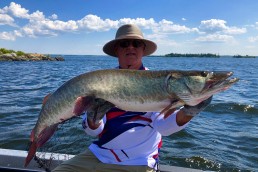Wind, Waves and Muskie Location
SHARE THIS POST
Joe Bucher explains that some knowledge of how wind effects a particular body of water will help put you on some really big fish.
Wind-induced current pushes volumes of water in one direction or another depending upon the specific wind direction at any given period of time. The result of this wind-induced current are waves. The stronger the wind, the larger the waves. Exactly how wind and terrain affects waves varies depending upon a number of factors.
For example, wave height is created by both wind speed, duration and fetch—which is basically the distance wind blows in a single direction uninterrupted. Furthermore, as waves approach a shoreline, friction between the bottom and the moving water cause turbulence and vertical angles.
Of course, a boat is pushed in a specific direction due to the wind. Fishermen commonly call this a drift. Boat drift is influenced by both wind force pushing against the vertical boat mass as well as current flow from water and wave movement.
Waves also move water around structure differently depending upon its direction and velocity. Predator gamefish, as well as baitfish, react to current no matter how much or how little there is. In fact, current of any kind usually forces fish to turn and face into it. If they are a dominant predator fish, they usually like to move up-current along a structure until they come to the uppermost front edge of it—where wave action collides with structure. Dominant active fish will most certainly want to be in this precise spot. The more ideal the conditions, the more often various big fish suddenly appear in the same precise upwind spot. This includes, in some instances, an entire school of big fish.
Reef-related muskies are particularly wind sensitive. They follow wind direction around like a compass. Always be very aware of this when you are on a good reef muskie pattern. Wind direction and subsequent wave action usually play a big role in muskie location on reefs. An active muskie is most apt to be on the upwind portion of the reef. There are always exceptions, of course.
Are you enjoying this post?
You can be among the first to get the latest info on where to go, what to use and how to use it!
Weed flat muskies relate similarly to wind direction and wave action depending upon the spot. I have seen muskies suddenly turn on along a thick wall of weeds that was dead a few hours earlier as soon as the wind picked up or switched. Usually, when the wind pounds steadily into one portion of a weed bed, whether it is in a bay, off a point, or any other type of weedy topography, a dominant active muskie is most apt to be positioned on the upwind edge of it.
Yet, one should also check the lee side, too, particularly if the wind and wave action are exceptionally strong and the structure is ultra shallow. I have seen times when the backside or lee portion of a wave-smashed island as well as a dangerously shallow reef, outproduced the front side containing all the wind-induced current and strong waves. Most often, I have witnessed these lee spots outproducing the wind/wave-pounded front side during late afternoons when sun exposure and solar heat draw baitfish. But it also occurs when wave action is too strong.
So, what happens when there’s no wind? Well, common sense pretty much explains the answer. There is no current to concentrate and isolate a fish to a specific spot. Muskie location usually becomes far less predictable. With no current along a specific reef structure, for example, there’s no reason why a muskie must position itself on one particular spot. Instead, they freely roam and feed wherever they want to.
Get more great fishing tips from the pros who know in every issue of MidWest Outdoors, available the first full week of each month at the newsstand or by subscribing on our website.
MWO
SHARE THIS POST
You may also like...
Nothing found.
Did you enjoy this post?
You can be among the first to get the latest info on where to go, what to use and how to use it!
Joe Bucher
Joe Bucher is a Freshwater Fishing Hall of Fame Legendary Angler, book author, lure designer and host of Fishing with Joe Bucher TV series.
